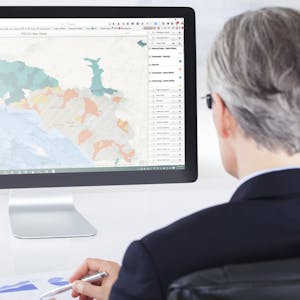In this course, the second in the Geographic Information Systems (GIS) Specialization, you will go in-depth with common data types (such as raster and vector data), structures, quality and storage during four week-long modules: Week 1: Learn about data models and formats, including a full understanding of vector data and raster concepts. You will also learn about the implications of a data’s scale and how to load layers from web services.
Week 2: Create a vector data model by using vector attribute tables, writing query strings, defining queries, and adding and calculating fields. You’ll also learn how to create new data through the process of digitizing and you’ll use the built-in Editor tools in ArcGIS.
Week 3: Learn about common data storage mechanisms within GIS, including geodatabases and shapefiles. Learn how to choose between them for your projects and how to optimize them for speed and size. You’ll also work with rasters for the first time, using digital elevation models and creating slope and distance analysis products.
Week 4: Explore datasets and assess them for quality and uncertainty. You will also learn how to bring your maps and data to the Internet and create web maps quickly with ArcGIS Online.
Take GIS Data Formats, Design and Quality as a standalone course or as part of the Geographic Information Systems (GIS) Specialization. You should have equivalent experience to completing the first course in this specialization, Fundamentals of GIS, before taking this course. By completing the second class in the Specialization you will gain the skills needed to succeed in the full program.
Design data tables and use separating and joining data in a relational database
Write query strings to subset data
Create and work with raster data
Syllabus
Syllabus - What you will learn from this course
Week 1
Course Overview & Data Models and Formats
Week 2
Creating and Working with Vector Data
Week 3
Storage Formats and Working with Rasters
Week 4
Data Quality and Creating Web Maps
FAQ
When will I have access to the lectures and assignments?
Access to lectures and assignments depends on your type of enrollment. If you take a course in audit mode, you will be able to see most course materials for free. To access graded assignments and to earn a Certificate, you will need to purchase the Certificate experience, during or after your audit. If you don't see the audit option:
The course may not offer an audit option. You can try a Free Trial instead, or apply for Financial Aid.
The course may offer 'Full Course, No Certificate' instead. This option lets you see all course materials, submit required assessments, and get a final grade. This also means that you will not be able to purchase a Certificate experience.
What will I get if I subscribe to this Specialization?
When you enroll in the course, you get access to all of the courses in the Specialization, and you earn a certificate when you complete the work. Your electronic Certificate will be added to your Accomplishments page - from there, you can print your Certificate or add it to your LinkedIn profile. If you only want to read and view the course content, you can audit the course for free.
Is financial aid available?
Yes. In select learning programs, you can apply for financial aid or a scholarship if you can’t afford the enrollment fee. If fin aid or scholarship is available for your learning program selection, you’ll find a link to apply on the description page.
What prior experience do I need to take this course?
You should have some experience in GIS before taking this course - it's not for absolute beginners. This is the second course in the Geographic Information Systems specialization, and you should have taken Fundamentals of GIS here on Coursera before enrolling in this course, or have equivalent experience. If you're not sure if you have equivalent experience, you can audit Fundamentals of GIS for free to look through the materials and fill in any gaps.
Since all of the courses in the specialization run monthly, you won't miss out on this course by enrolling in Fundamentals of GIS first. This course will have a new session once you have the skills needed to take it.
Reviews
it helped me a lot in mastering vector data and editing them, gave me an introdustion to how raster data works, also i knew details about the types of databases in detail.
The best thing about this source is I had learned web mapping. This course give me clear concept about GIS data format and how to design correctly with maintaining quality.
Nick, you and your team did good job on making the course enjoyable, only problem I faced was having trouble downloading the tutorial 2 assignment data. Still it was a very good experience!!!
The course has opened my eyes to a lot of new concepts, workflows and tools in ArcMap. Challanging, fun, motivating and educating. very pleased with myself for taking it on.
